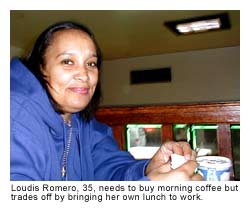|
Sacrifices for your future
|
 |
April 12, 2000: 11:10 a.m. ET
Practical trade-offs that will get you to your retirement dream
By Staff Writer Jennifer Karchmer
|
NEW YORK (CNNfn) - Did you know that if you passed up your daily café latte you could save almost $150,000 for your retirement? And if you ordered takeout instead of dining out once a month you could bank away $83,000 over the long haul?
You're already making automatic deductions into your 401(k) plan at work, so what else can you do to beef up your retirement account?
Ask 35-year-old Loudis Romero.
On her way to her factory job in Manhattan, she insists on buying coffee at her favorite deli on the corner of 36th Street and 9th Avenue. But to offset her weekly java expense, she totes a brown bag lunch which allows her to save her lunch money for retirement.
"I have to have my coffee," she said. "But I think it's better to bring my lunch."

So in addition to socking away money into an IRA account and employer-sponsored plans, investors can make sacrifices that can add up to big long-term savings.
But you have to decide if you're willing to make the trade-off between a more extravagant lunch today or few extra bucks in your 80s.
"Some people think that we're kind of headed toward a train wreck when it comes to baby boomers' saving," said Don Blandin, president of the American Savings Education Council (ASEC). "They're saving, but not enough. Their money could retire before they're done retiring, which could cause a strain on our national fabric."
Are you in the ballpark?
Thirty percent of Americans have not put any money aside specifically for retirement, according to ASEC. Also, 25 percent of people who have 401(k) plans at work don't participate in them.
But there is a silver lining in this investment cloud. Many investors are starting to drop their pennies in the piggy bank -- but they're doing so without a plan.

So financial experts say the first thing to do is figure out a ballpark estimate of how much you'll need during retirement and where your income will come from. For many, that means an employer-sponsored plan, an IRA, a company pension, Social Security benefits, and any additional savings.
"After you've done the numbers, and it's not rocket science to do that, you may have a gap," Blandin added. "The earlier you know that, the better. The time to discover that is not when you're retiring."
Comfort zone
So your annual salary is $50,000, you've got about $10,000 socked away in your 401(k), and you've got another 35 years until retirement. The calculator shoots out $5,000/year as the magic number you need to save to live in retirement.

And you want to live comfortably during your golden years -- in a New England country house instead of a cramped apartment in the city. So how can you reach that goal without taking on another job or eating boxed macaroni and cheese every night?
Skip the Starbucks?
Let's say you spend an extra $4 a day on gourmet coffee and a croissant for breakfast.
If you take that $80 month and invest it in a mutual fund, you could have $146,000 in 25 years, assuming a 12 percent annualized market return average, according to certified financial planner (CFP) Ken Stern with Asset Planning Solutions in San Diego.
Consider these other tradeoffs, which assume a 9 percent annual rate of return compounded at the same rate of contributions over a 30-year period:
* Order takeout instead of dining at the restaurant once a month (you save $45/month=$83,001).
* Buy home exercise equipment instead of a gym membership ($300/year=$44,572).
* Rent movies instead of going to the cinema ($11/month=$20,289).
Easier said than done?
You've decided to forgo the Starbucks in the morning and slug down the free coffee from the machine at work. And you promise to get up early in the morning to make peanut butter & jelly sandwiches for lunch instead of eating gourmet salads from the deli downstairs.
Click here to take the retirement personality profiler quiz!!
How do you stick to your plan?
Carry a pad of paper and pencil everywhere you go for one month keeping track of all purchases, from meals to clothes to the 50-cent pack of gum at the newsstand, Stern advises.
At the end of the month, categorize the purchases and tally them up to see where you can cut out the fat. Do you really need a professional manicure every week? Can you and your friends rent a black-and-white classic instead of hitting the multiplex on Friday nights?
"It's all a mindset," Stern said.
Getting fund savvy
So now that you're inking down your expenses and saving here and there, you're ready to set that money aside for the long haul.
Create automatic savings deductions of $25 or $50 per pay period from your bank checking account or directly from your paycheck, if possible, into a mutual fund.
Stern suggests you consider general all-purpose growth funds, such as the ASAF Janus Capital Growth Fund (JCGAX), with a 1999 return of 50.31 percent, or the AIM Value Fund (AVLFX), which had a 1999 return of 29.95 percent, according to Morningstar.
The bottom line is to make a plan and stick to it.
"People have to balance their consumption with their formation of their nest egg," said ASEC's Blandin. "They have to not sacrifice tomorrow for being able to spend all they possibly can today." 
-- Click here to send comments about this story to Staff Writer Jennifer Karchmer.
|
|
|
|
|
 |

|

